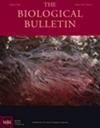揭示共生和温度对珊瑚钙化的影响
IF 1.9
4区 生物学
Q2 BIOLOGY
引用次数: 0
摘要
我们使用兼性共生珊瑚Astrangia poculata作为模型系统,测试了温度和共生状态对珊瑚钙化的影响。在15、20和27°C的条件下饲养了A.poculata的共生和非共生菌落。我们使用扫描电子显微镜来量化这些生理和环境条件如何影响骨骼结构。浮力随时间变化的数据显示,温度显著影响钙化率。对A.poculata骨骼的扫描电子显微镜显示,在活跃生长的隔棘中,无共生菌落的碳酸钙密度似乎较低。我们描述了一种分析扫描电子显微镜图像粗糙度和纹理的新方法。对间隔棘粗糙度的定量分析表明,在热带条件下(27°C),无共生菌落的表面比共生菌落的粗糙。这种趋势在15°C时逆转,在这个温度下,a.poculata的共生体可能表现出寄生特性。对表面纹理图案的分析表明,温度影响脊柱表面晶体的空间变化。很少有已发表的研究通过扫描电子显微镜检查A.poculata的骨骼。我们的方法提供了一种研究骨骼微观结构响应环境参数的详细变化的方法,并可以作为更昂贵和耗时的分析的代理。利用一种原产于温带和热带地区的兼性共生珊瑚,为共生和温度对珊瑚钙化的影响提供了新的见解。本文章由计算机程序翻译,如有差异,请以英文原文为准。
Uncovering the Effects of Symbiosis and Temperature on Coral Calcification
We tested the impact of temperature and symbiont state on calcification in corals, using the facultatively symbiotic coral Astrangia poculata as a model system. Symbiotic and aposymbiotic colonies of A. poculata were reared in 15, 20, and 27 °C conditions. We used scanning electron microscopy to quantify how these physiological and environmental conditions impact skeletal structure. Buoyant weight data over time revealed that temperature significantly affects calcification rates. Scanning electron microscopy of A. poculata skeletons showed that aposymbiotic colonies appear to have a lower density of calcium carbonate in actively growing septal spines. We describe a novel approach to analyze the roughness and texture of scanning electron microscopy images. Quantitative analysis of the roughness of septal spines revealed that aposymbiotic colonies have a rougher surface than symbiotic colonies in tropical conditions (27 °C). This trend reversed at 15 °C, a temperature at which the symbionts of A. poculata may exhibit parasitic properties. Analysis of surface texture patterns showed that temperature impacts the spatial variance of crystals on the spine surface. Few published studies have examined the skeleton of A. poculata by using scanning electron microscopy. Our approach provides a way to study detailed changes in skeletal microstructure in response to environmental parameters and can serve as a proxy for more expensive and time-consuming analyses. Utilizing a facultatively symbiotic coral that is native to both temperate and tropical regions provides new insights into the impact of both symbiosis and temperature on calcification in corals.
求助全文
通过发布文献求助,成功后即可免费获取论文全文。
去求助
来源期刊

Biological Bulletin
生物-海洋与淡水生物学
CiteScore
3.30
自引率
6.20%
发文量
47
审稿时长
6-12 weeks
期刊介绍:
The Biological Bulletin disseminates novel scientific results in broadly related fields of biology in keeping with more than 100 years of a tradition of excellence. The Bulletin publishes outstanding original research with an overarching goal of explaining how organisms develop, function, and evolve in their natural environments. To that end, the journal publishes papers in the fields of Neurobiology and Behavior, Physiology and Biomechanics, Ecology and Evolution, Development and Reproduction, Cell Biology, Symbiosis and Systematics. The Bulletin emphasizes basic research on marine model systems but includes articles of an interdisciplinary nature when appropriate.
 求助内容:
求助内容: 应助结果提醒方式:
应助结果提醒方式:


